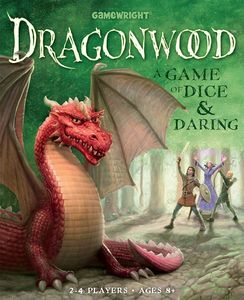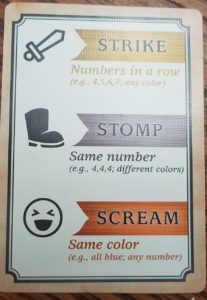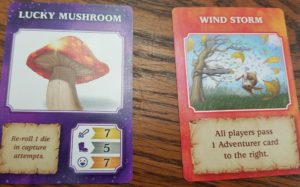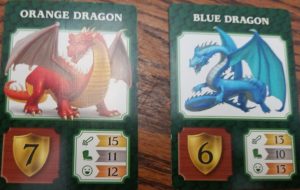
We picked this game up for my wife’s birthday. We’ve had some success with other Gamewright games and this one proved par for the course.
Production- A-
 The cards are reasonably sturdy. They’re smooth and glossy without being too slick. It comes with custom dice and the box has slots to store everything. The rules are simple and easily understood. Only knock is that it only comes with two Turn Summary reminder cards for a game of up to four players. You don’t really need them after a play through. Their main function is to remind you which card combos are which and you’ll pick that up quickly.
The cards are reasonably sturdy. They’re smooth and glossy without being too slick. It comes with custom dice and the box has slots to store everything. The rules are simple and easily understood. Only knock is that it only comes with two Turn Summary reminder cards for a game of up to four players. You don’t really need them after a play through. Their main function is to remind you which card combos are which and you’ll pick that up quickly.
Theme- B+
You’re cast in the roles of heroic adventurers out to slay scary beasts. You will face many monsters of all sorts, including two powerful dragons. Whoever defeats the most and the strongest monsters is declared the greatest hero.
 The game’s artwork conveys its fantasy themes. There are three types of cards; Adventurer, Creature, and Enhancement. Each card contains game mechanics information and appropriate artwork. The Adventurer cards are broken into five colors with each color having a classic fantasy class on it; wizards, rogues, rangers, sorcerers, warriors. The Creatures are fearsome without being gory or graphic. The Enhancement’s graphics look the most cartoony as they are mostly pictures of items rather than living things.
The game’s artwork conveys its fantasy themes. There are three types of cards; Adventurer, Creature, and Enhancement. Each card contains game mechanics information and appropriate artwork. The Adventurer cards are broken into five colors with each color having a classic fantasy class on it; wizards, rogues, rangers, sorcerers, warriors. The Creatures are fearsome without being gory or graphic. The Enhancement’s graphics look the most cartoony as they are mostly pictures of items rather than living things.
The cards look great and, for the most part, do their job of conveying needed information. Their one fault is that the mechanic numbers you need to refer to are comparatively small. The artwork takes up over half the card, which makes them look cool, but the numbers you need to see are scrunched into the corner. When you’re looking at them at an angle from across the table this necessitates constantly needing to pick them up to see. But that’s just a small nitpick.
Gameplay- B
 The monsters, creatures as the game refers to them, are all worth a certain amount of victory points. The player who has the most at the end of the game, wins. The points range from one to seven with the two dragons being worth the most. The higher the victory point value, the harder a creature is to capture. The game ends when both dragons have been defeated or the Adventure deck has been reshuffled twice. So far all our games have ended with the dragons being taken.
The monsters, creatures as the game refers to them, are all worth a certain amount of victory points. The player who has the most at the end of the game, wins. The points range from one to seven with the two dragons being worth the most. The higher the victory point value, the harder a creature is to capture. The game ends when both dragons have been defeated or the Adventure deck has been reshuffled twice. So far all our games have ended with the dragons being taken.
To defeat a monster you must play a set of cards from your hand. The cards you play are either runs (1,2,3,etc) referred as a Strike (yellow), number matches (4,4,4) called Stomps (grey), or color matches (all blue) called Scream (orange). Each monster has different values for each type of play. When you play your cards you then roll a die for each card played and add them up. If you meet or exceed the number, you defeat the creature and add it to your collection. The dice are non-standard d6’s with one “1”, two “2”s, two “3”s and one “4”. That puts the average result at 2.5. If you wanted to Strike that Orange Dragon (15), you’d need a minimum of four cards (max result of 4 x 4 >15) but six to have a reasonable chance of success (average result of 2.5 x 6= 15).
On your turn you can either attempt to defeat a monster by playing cards or draw a new card (called Reloading and you are encouraged to call out “Reloading!” when you do). If you fail in your attempt at a monster, you get to keep the cards you used but must discard any one card from your hand. If you capture the monster, the cards you played go into the discard pile. You can have a maximum of nine cards in your hand.
There are also Enhancement and Event cards that are part of the Creature deck. Event cards trigger something to happen, such as all players drawing a card, and then are replaced with the next card. Enhancements are captured just like creatures. Several of the enhancement cards are one time use cards which can be very handy. Enhancements don’t go in your hand so you can use them whenever you need without affecting your hand limit. Others are permanent bonuses and this is where the game runs into some balance trouble.
One permanent bonus gives you a dice reroll which is nice but not game breaking. The rest add fixed bonuses to certain capture attempts (such as +2 to Strike or +2 to Scream). This has a nice D&D feel to it which is cool. Unfortunately, two cards give bonuses to every roll you make and one of the capture attempts, Stomps, is always the lowest number on a monster. By the nature of the deck, it’s harder to get multiples of a single number than it is to get sets of colors or runs. Hence why the Stomp is a creature’s lowest value. But when you pair this with the Enhancement to it, and/or the Enhancement to everything, it suddenly becomes the most important card. With the Cloak of Darkness (+2 to everything) and Bucket of Spinach (+2 to Stomp) you can capture most creatures with 1 or 2 cards played. You can capture the most valuable dragon reliably with only three cards.
Expansions- TBD
None that I am aware of.
Conclusion- B+
This is a fun and relatively quick family game. You need to do some math so good for kids. It leans into some RPG concepts. The mechanics are simple and easy to understand. The instruction booklet is clear and well organized. Even the major issue with the potential card balance is addressed to a degree in that each game you discard a fixed number of random cards. For any game, you don’t know which cards will even come up (except the two dragons). Worth a play through if your family likes fantasy settings.
Wayne Basta
Latest posts by Wayne Basta (see all)
- X-Wing Tier List – Rebels - May 10, 2023
